Hummingbirds are delightful creatures that bring joy and beauty to our gardens with their vibrant colors and swift movements. However, the presence of wasps around hummingbird feeders can pose a challenge for both the birds and the humans who wish to attract them.
Wasps are attracted to the sweet nectar in hummingbird feeders and can deter hummingbirds from feeding, or worse, create a hostile environment for them.
Fortunately, there are effective measures that can be taken to keep wasps away from hummingbird feeders, ensuring a safe and inviting space for these beloved avian visitors.
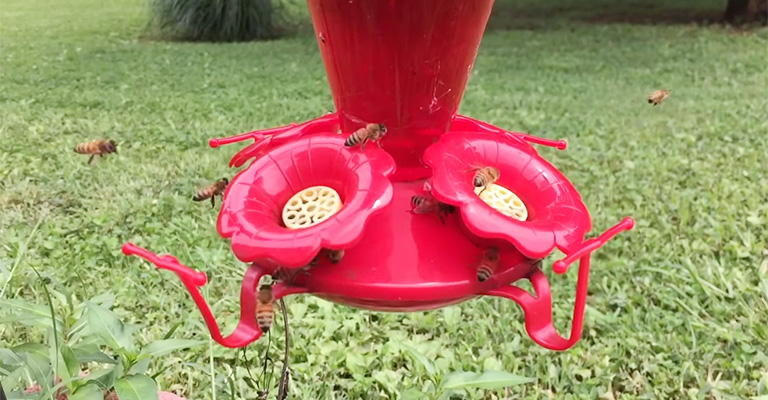
Understanding Wasps and Their Attraction
Wasps are social insects belonging to the Hymenoptera order, which also includes bees and ants. They have slender bodies with narrow waists, and their colors range from black to various shades of yellow and brown.
Unlike honeybees, which have barbed stingers and typically die after stinging, wasps can sting multiple times without consequence.
Wasps are known for their aggressive nature when defending their nests or food sources. They are highly territorial and protective of their colonies.
During warmer months, wasp colonies expand, and individual wasps venture out in search of food and resources.
Why Wasps Are Attracted to Hummingbird Feeders?
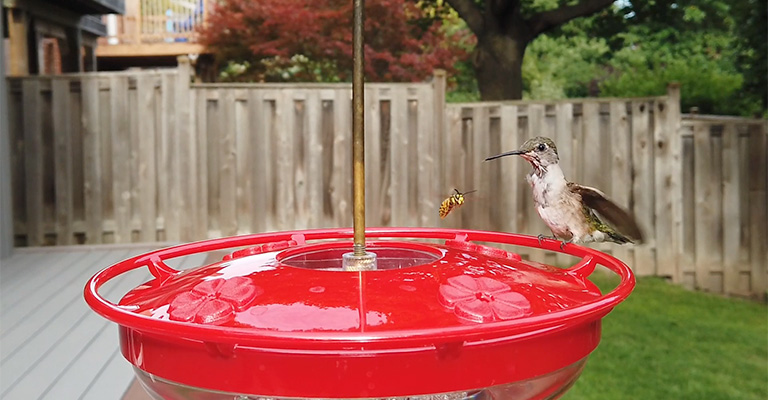
Hummingbird feeders, with their sweet nectar, act as a magnet for wasps. There are several reasons why wasps are drawn to these feeders:
Sugar Cravings
Like many insects, wasps have a natural affinity for sugary substances. The high concentration of sugar in hummingbird nectar makes it an irresistible food source for wasps.
Availability of Food
Hummingbird feeders provide a consistent and easily accessible supply of nectar. Wasps quickly learn to associate feeders with a reliable source of nourishment.
Yellow Coloration
Some hummingbird feeders incorporate yellow elements, which can attract wasps more than the color red. Wasps are particularly drawn to yellow hues and may mistake the feeder for a potential food source.
Negative Impact of Wasp Presence on Hummingbirds
The presence of wasps around hummingbird feeders can have negative consequences for these tiny birds:
Intimidation and Aggression
Wasps are larger and more assertive than hummingbirds. Their presence can intimidate hummingbirds and prevent them from feeding comfortably or landing on the feeders altogether.
Increased Stress Levels
Hummingbirds rely on frequent feeding to maintain their high metabolism. When wasps dominate the feeding area, hummingbirds may experience heightened stress levels, leading to reduced feeding and potential health implications.
Nest Disruption
In some cases, wasps may attempt to build nests near or around hummingbird feeders. This can disturb the natural nesting behavior of hummingbirds and impact their overall breeding success.
Understanding the characteristics, behavior, and attraction of wasps to hummingbird feeders highlights the importance of finding effective methods to deter them.
By addressing this issue, we can create a safe and welcoming environment for hummingbirds to thrive and enjoy their essential nectar sources without interference.
Essential Steps for Wasp-free Hummingbird Feeders
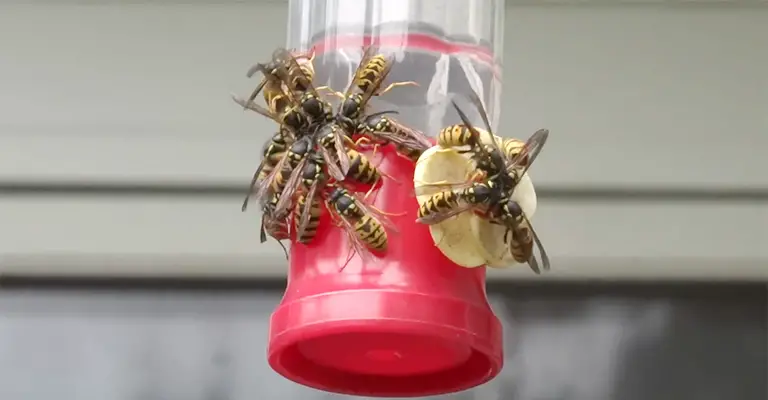
Please check the following steps for Wasp-free Hummingbird feeders. Make sure to follow the steps sequentially.
Regular Cleaning and Maintenance of Feeders
Keeping your hummingbird feeders clean is essential for preventing the buildup of residue that may attract wasps. Regularly wash the feeders with hot water and mild soap, ensuring all parts are thoroughly cleaned.
Rinse them well before refilling them with fresh nectar. By maintaining clean feeders, you discourage wasps from being attracted to the remnants of sugar or nectar.
Using Saucer Feeders With Built-in Ant Moats
Saucer-style hummingbird feeders with built-in ant moats are an effective solution for deterring not only ants but also wasps. Ant moats are small reservoirs located above the feeder openings, filled with water.
The water creates a barrier that prevents ants and wasps from reaching the nectar. This design feature helps ensure that only hummingbirds can access the feeding ports.
Removing Yellow Flowers and Avoiding Strong Scents
Wasps are attracted to bright colors, including yellow flowers. To minimize their attraction to your hummingbird feeders, remove or relocate any yellow flowers in the vicinity.
Hanging Feeders in Open Spaces With Fishing Lines
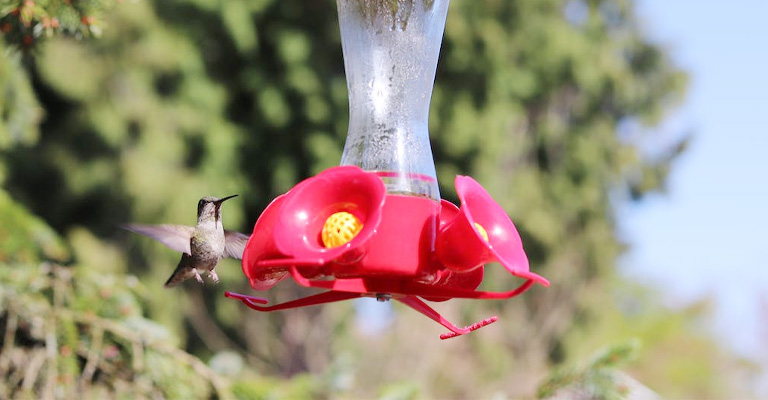
Wasps are less likely to visit hummingbird feeders if they are hung in open spaces, away from dense foliage or structures where wasp nests may be present.
Hanging feeders with fishing lines can further deter wasps, as they may find it challenging to land on the thin line. This method creates an additional obstacle for wasps, reducing their access to feeders.
Utilizing Fake Wasp Nests as Deterrents
Wasps are territorial creatures. By placing fake wasp nests near your hummingbird feeders, you can create the illusion of an already occupied territory.
Wasps are less likely to establish nests or visit an area they perceive as already claimed by another colony. You can find artificial wasp nests for purchase or create your own using materials like brown paper bags.
Strategic placement of these nests around the feeders can help deter wasps.
Incorporating Natural Repellents and Plants Disliked by Wasps
Certain natural repellents and plants disliked by wasps can be effective in deterring them from your hummingbird feeders.
Planting herbs and flowers with strong scents that wasps dislike, such as spearmint, eucalyptus, lemongrass, or marigolds, can help create a less attractive environment for wasps.
Additionally, placing slices of cucumber or citrus fruit near the feeders may act as natural deterrents.
By implementing these essential steps, you can significantly reduce wasp activity around your hummingbird feeders, creating a more inviting space for the hummingbirds while ensuring their uninterrupted feeding experience.
Detailed Tips and Techniques
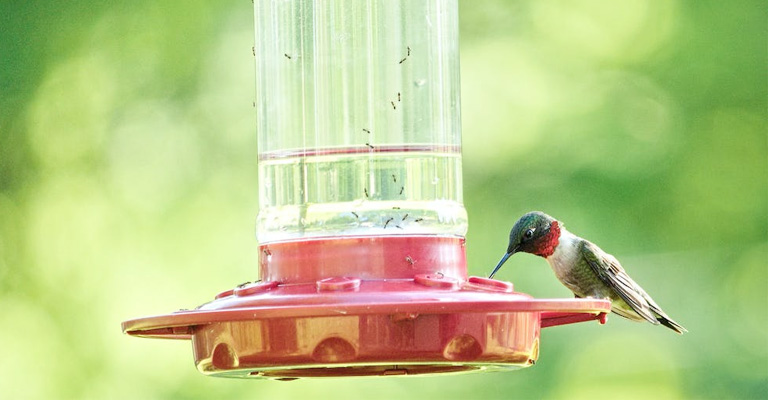
I know some essential tips and techniques that work great in this context. Please check them right below.
Instructions for Cleaning Hummingbird Feeders
Regular cleaning of hummingbird feeders is essential for maintaining hygiene and preventing wasp attraction. This subsection will provide a step-by-step guide on how to clean your feeders properly.
It will cover aspects such as disassembly, washing with hot water and mild soap, thorough rinsing, and drying methods. By following these instructions, you can ensure a clean feeding station that is less appealing to wasps.
Benefits and Selection Criteria for Saucer-style Feeders
Saucer-style feeders with built-in ant moats have proven to be effective in deterring wasps from accessing the nectar. This subsection will discuss the benefits of using such feeders and provide selection criteria to help you choose the right one for your needs.
It will cover aspects like capacity, durability, ease of cleaning, and the presence of ant moats. By opting for saucer-style feeders, you can create an additional barrier to keep wasps at bay.
Identifying and Removing Yellow Flowers From the Vicinity
Wasps are attracted to bright colors, including yellow flowers. This subsection will guide you in identifying any yellow flowers in the vicinity of your hummingbird feeders and provide methods for their removal or relocation.
By eliminating these visual attractants, you can reduce the likelihood of wasp presence near the feeders.
Guidelines for Hanging Feeders With Fishing Line
Hanging feeders in open spaces with fishing lines can deter wasps from reaching the feeders. This subsection will provide guidelines on how to properly hang your feeders using a fishing line.
It will cover aspects such as selecting suitable hanging locations, determining the right height, and securing the line effectively. By following these guidelines, you can create a physical barrier that makes it challenging for wasps to land on the feeders.
Diy Fake Wasp Nests and Their Placement Strategies
Creating and strategically placing fake wasp nests near your hummingbird feeders can help deter wasps. This subsection will provide instructions for crafting DIY fake wasp nests using materials like brown paper bags.
It will also discuss effective placement strategies for these nests, considering factors such as visibility and territorial behavior. By incorporating fake nests, you can discourage wasps from establishing nests or approaching the feeding area.
List of Natural Wasp Repellents and Planting Suggestions
Certain natural repellents and plants disliked by wasps can assist in deterring them from your hummingbird feeders. This subsection will provide a list of natural repellents, such as essential oils or scents that wasps dislike.
It will also offer planting suggestions for herbs, flowers, or other plants that can create an environment less attractive to wasps. By incorporating these natural deterrents, you can further discourage wasp activity around your feeders.
Safety Considerations and Eco-friendly Approach
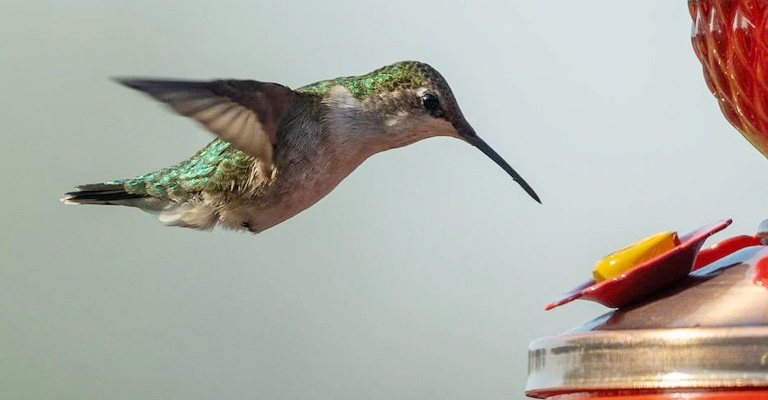
In this case, it is essential to consider a few safety tips. Make sure to follow the below tips, especially for an eco-friendly Approach.
Importance of Avoiding Harmful Pesticides and Traps
Using harmful pesticides or traps to control wasps near hummingbird feeders can have adverse effects on the overall ecosystem and pose risks to other beneficial insects, animals, and even humans.
This subsection will emphasize the significance of avoiding such methods and explore alternative, environmentally friendly approaches to discourage wasp presence.
By opting for safe solutions, we can maintain a healthy and balanced environment.
Safe Environment for Both Hummingbirds and Wasps
Hummingbirds and wasps play essential roles in our ecosystem, and it is crucial to create a safe environment that accommodates both species. This subsection will discuss ways to achieve a harmonious coexistence, such as keeping feeders clean, providing ample feeding space, and implementing natural deterrents.
By promoting safety and minimizing conflicts, we can support the well-being of both hummingbirds and wasps.
Respecting the Role of Wasps as Beneficial Pollinators
While wasps may be considered pests at times, it is important to recognize their valuable role as pollinators. This subsection will shed light on the positive contributions wasps make to pollination and ecosystem health.
It will emphasize the need to strike a balance between deterring wasps from hummingbird feeders while still respecting their ecological significance.
By understanding and appreciating the ecological roles of wasps, we can cultivate a deeper appreciation for the natural world.
Comparison of Methods to Keep Wasps Away From Hummingbird Feeders
| Methods | Description | Pros | Cons |
| Regular cleaning and maintenance | Regularly clean feeders to remove residue attracting wasps | Maintains cleanliness of feeders | Requires consistent upkeep |
| Saucer-style feeders with ant moats | Feeders with built-in ant moats prevent wasp access | Effectively deters both ants and wasps | A limited selection of feeders with ant moats |
| Removal of yellow flowers | Remove or relocate yellow flowers that attract wasps | Reduces visual attraction for wasps | May impact garden aesthetics |
| Hanging feeders with fishing line | Hang feeders in open spaces using fishing line as a deterrent | Creates a physical barrier for wasps to land | Requires careful installation and maintenance |
| DIY fake wasp nests | Place artificial wasp nests to create territorial deterrence | Mimics an occupied territory for wasps | Effectiveness may vary; may not work for all wasp species |
| Natural repellents and planting | Incorporate plants or scents disliked by wasps around feeders | Provides natural deterrents for wasps | Requires knowledge of suitable repellent plants |
FAQs
It is strongly recommended to avoid using harmful pesticides near hummingbird feeders. Pesticides can pose risks to the health of both hummingbirds and other beneficial insects, disrupt the ecosystem balance, and potentially contaminate the nectar, which could harm the hummingbirds.
It is best to opt for eco-friendly and non-toxic deterrent methods.
While removing wasp nests may temporarily alleviate the immediate wasp presence, it may not be a foolproof solution. Wasps can rebuild nests or establish new ones nearby, especially if the food source (nectar) is still available.
It is recommended to implement a combination of deterrent methods, such as those discussed earlier, to effectively keep wasps away from the feeders.
It is advisable to avoid using chemical wasp repellents around hummingbird feeders, as these substances may pose risks to hummingbirds and other beneficial insects.
Chemical repellents may also contaminate the nectar, rendering it unsafe for hummingbirds. Instead, focus on natural repellents like certain plant scents disliked by wasps or the placement of fake wasp nests.
While wasps can be aggressive and intimidating to hummingbirds, they generally do not pose a direct threat. Hummingbirds have the agility and speed to avoid confrontations with wasps.
However, the presence of wasps can cause stress and deter hummingbirds from accessing the feeders, affecting their feeding patterns and potentially impacting their overall well-being.
Minimizing wasp presence around the feeders creates a more comfortable environment for hummingbirds.
It is generally not recommended to use wasp traps near hummingbird feeders. While traps can be effective at capturing wasps, they may also inadvertently trap or harm other beneficial insects and pose risks to the environment.
It is preferable to focus on preventative measures like those discussed earlier to deter wasps without resorting to traps.
Conclusion
Keeping wasps away from hummingbird feeders is achievable through a combination of effective methods and mindful practices.
Regular cleaning, using saucer-style feeders with ant moats, removing yellow flowers, hanging feeders in open spaces, utilizing fake wasp nests, and incorporating natural repellents all contribute to creating a welcoming environment for hummingbirds while deterring wasp activity.
Prioritizing safety and respecting the role of wasps as pollinators ensures a balanced and eco-friendly approach.
Hopefully, you understand well. Make sure to follow the steps sequentially and ensure the safety tips. Thank you for your time.